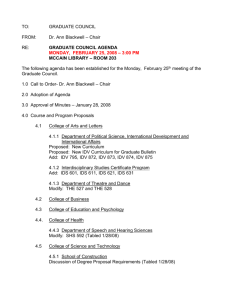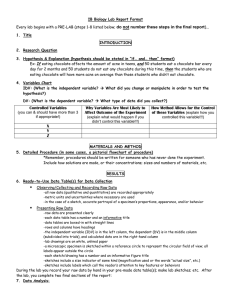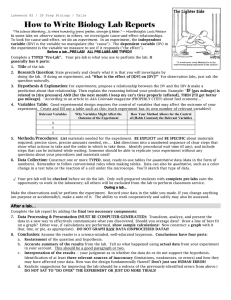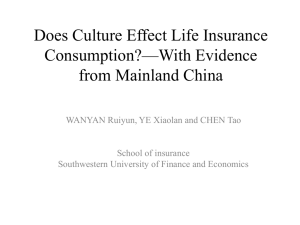Hindawi Publishing Corporation International Journal of Mathematics and Mathematical Sciences
advertisement
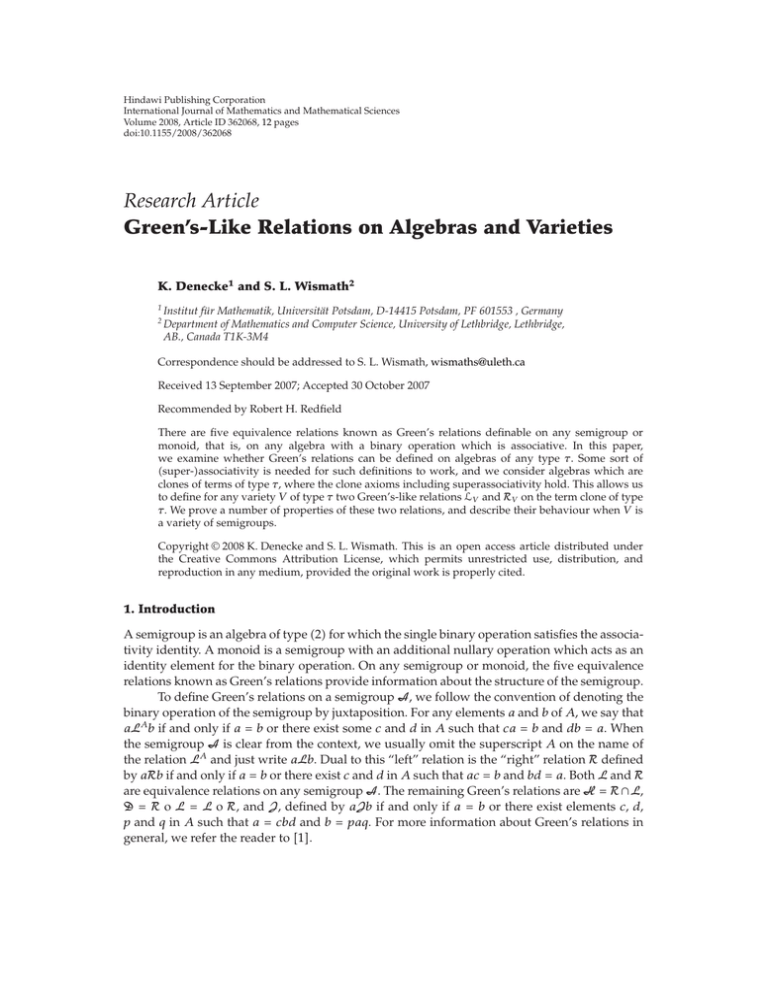
Hindawi Publishing Corporation
International Journal of Mathematics and Mathematical Sciences
Volume 2008, Article ID 362068, 12 pages
doi:10.1155/2008/362068
Research Article
Green’s-Like Relations on Algebras and Varieties
K. Denecke1 and S. L. Wismath2
1
2
Institut für Mathematik, Universität Potsdam, D-14415 Potsdam, PF 601553 , Germany
Department of Mathematics and Computer Science, University of Lethbridge, Lethbridge,
AB., Canada T1K-3M4
Correspondence should be addressed to S. L. Wismath, wismaths@uleth.ca
Received 13 September 2007; Accepted 30 October 2007
Recommended by Robert H. Redfield
There are five equivalence relations known as Green’s relations definable on any semigroup or
monoid, that is, on any algebra with a binary operation which is associative. In this paper,
we examine whether Green’s relations can be defined on algebras of any type τ. Some sort of
super-associativity is needed for such definitions to work, and we consider algebras which are
clones of terms of type τ, where the clone axioms including superassociativity hold. This allows us
to define for any variety V of type τ two Green’s-like relations LV and RV on the term clone of type
τ. We prove a number of properties of these two relations, and describe their behaviour when V is
a variety of semigroups.
Copyright q 2008 K. Denecke and S. L. Wismath. This is an open access article distributed under
the Creative Commons Attribution License, which permits unrestricted use, distribution, and
reproduction in any medium, provided the original work is properly cited.
1. Introduction
A semigroup is an algebra of type 2 for which the single binary operation satisfies the associativity identity. A monoid is a semigroup with an additional nullary operation which acts as an
identity element for the binary operation. On any semigroup or monoid, the five equivalence
relations known as Green’s relations provide information about the structure of the semigroup.
To define Green’s relations on a semigroup A, we follow the convention of denoting the
binary operation of the semigroup by juxtaposition. For any elements a and b of A, we say that
aLA b if and only if a b or there exist some c and d in A such that ca b and db a. When
the semigroup A is clear from the context, we usually omit the superscript A on the name of
the relation LA and just write aLb. Dual to this “left” relation is the “right” relation R defined
by aRb if and only if a b or there exist c and d in A such that ac b and bd a. Both L and R
are equivalence relations on any semigroup A. The remaining Green’s relations are H R ∩ L,
D R o L L o R, and J, defined by aJb if and only if a b or there exist elements c, d,
p and q in A such that a cbd and b paq. For more information about Green’s relations in
general, we refer the reader to 1.
2
International Journal of Mathematics and Mathematical Sciences
In this paper, we consider how one might extend the definitions of the five Green’s relations to algebras of any arbitrary type. In Section 2, we propose some definitions for L and R,
and show what properties are needed to make our relations into equivalence relations. Then
we consider a variation which extends our definition of two relations L and R to relations LV
and RV on the term clone of any variety V . In Section 3, we deduce a number of properties of
these two relations, and then in Section 4 we examine their behaviour when V is a variety of
semigroups.
2. Green’s relations for any type
We begin with some notation. Throughout this paper, we will assume a type τ ni i∈I , with an
ni -ary operation symbol fi for each index i in some set I. For each n ≥ 1, we let Xn {x1 , . . . , xn }
be an n-element alphabet of variables, and let Wτ Xn be the set of all n-ary terms of type τ.
Then we set X {x1 , x2 , x3 , . . . }, and let Wτ X denote the set of all finitary terms of type τ.
Terms can be represented by tree diagrams called semantic trees. We will use the well-known
Galois connection Id-Mod between classes of algebras and sets of identities. For any class K of
algebras of type τ and any set Σ of identities of type τ, Mod Σ is the class of all algebras A of
type τ which satisfy all the identities in Σ, while IdK is the set of all identities s ≈ t of type τ
which are satisfied by all algebras in K.
As a preliminary step in defining Green’s relations on any algebra of arbitrary type, let
us consider first the case of type τ n, where we have a single operation symbol f of arity
n ≥ 1. In analogy with the two left and right Green’s relations L and R for type 2, we can
define n different Green’s-like relations here. Let A be an algebra of type n and let a and b
be elements of A. For each 1 ≤ j ≤ n, set a Gj b if and only if a b or there exist elements
b1 , . . . , bj−1 , bj1 , . . . , bn and a1 , . . . , aj−1 , aj1 , . . . , an in A such that
b f A a1 , . . . , aj−1 , a, aj1 , . . . , an .
2.1
a f A b1 , . . . , bj−1 , b, bj1 , . . . , bn ,
Each Gj for 1 ≤ j ≤ n is clearly a reflexive and symmetric relation on A, but as we will see is not
necessarily transitive for n ≥ 2. Of particular interest are the two relations G1 and Gn , which we
will denote by R and L, respectively.
Example 2.1. Let τ 1 be a type with one unary operation symbol f. In this case L R, and
we see that for any algebra A A; f A and any elements a, b ∈ A, we have aLb if and only if
a b, or a f A b and b f A a. Thus two distinct elements are related if and only if there is
a cycle between them in the algebra A. The relation L is transitive and hence an equivalence
relation: if aLb and bLc, and a /
b and b /
c, then we have a f A b, b f A a, b f A c,
A
A
and c f b. This forces a c f b, and so aLc. This also tells us that each element b ∈ A
can be L-related to at most one element other than itself.
If the type 1 algebra A has no cycles in it, we get simply L ΔA , the diagonal relation
on A. If A {a, b} with f A a b and f A b a, then L A × A. An algebra A in which there
are some cycles but not every element that has a cycle will result in L strictly between ΔA and
A × A.
Now consider an algebra A of an arbitrary type τ. Since there can be different operation
symbols of different arities in our type, we cannot define our relations Gj using the jth position
as before. But we can use the first and last position entries to define left and right relations.
This motivates the following definition.
K. Denecke and S. L. Wismath
3
Definition 2.2. Let A be any algebra of type τ. We define relations R and L on A as follows. For
any a, b ∈ A, we set
i aRb if and only if a b or a fiA b, b2 , . . . , bni and b fkA a, a2 , . . . , ank , for some i, k ∈ I
and some elements b2 , . . . , bni and a2 , . . . , ank in A.
ii aLb if and only if a b or a fiA b1 , . . . , bni −1 , b and b fkA a1 , . . . , ank −1 , a, for some
i, k ∈ I and some elements b1 , . . . , bni −1 and a1 , . . . , ank −1 in A.
Again these two relations are clearly seen to be reflexive and symmetric on the base set
A of any algebra A. It is the requirement of transitivity that causes problems, and forces us to
impose some restrictions on our algebra. For transitivity of R on an algebra A, suppose that a,
b, and c are in A, aRb, and bRc. In the special cases that a b or b c, we certainly have aRc, so
let us assume that a / b and b / c. Then we have a fiA b, b2 , . . . , bni and b fkA a, a2 , . . . , ank ,
and also b fpA c, c2 , . . . , cnp and c fqA b, d1 , . . . , dnq , for some operation symbols fi , fk , fp ,
and fq of our type and some elements b2 , . . . , bni , a2 , . . . , ank , c2 , . . . cnp , d2 , . . . , dnq of set A. By
substitution, we get
a fiA fpA c, c2 , . . . , cnp , b2 , . . . , bni ,
c fqA fkA a, a2 , . . . , ank , d1 , . . . , dnq .
2.2
A
c, e2 , . . . , enm for some operation symbol fm and some
But we need to be able to express a as fm
elements e2 , . . . , enm . For type 2, this is dealt with by the requirement that f A f A c, c2 , b2 can
be changed to f A c, f A c2 , b2 , that is, we have associativity in our algebra A. For arbitrary
types, it would suffice here to have a superassociative algebra, satisfying the superassociative
law:
f i f j x 1 , x 2 , . . . , x n j , y 2 , . . . , y n i ≈ f j x 1 , f i x2 , y 2 , . . . , y n i , . . . , f i x n j , y 2 , . . . , y n i .
2.3
This identity would allow us to express a as an element with c in the left-most position and
similarly to express c in terms of a. Another way to handle this would be to define aRb when
A
A A
a b or a tA
1 b, b2 , . . . , bn and b t2 a, a2 , . . . , am for some term operations t1 , t2 on A and
some elements a2 , . . . , am , b2 , . . . , bn of A. In either approach, we are led to consider clones of
terms.
A clone is an important kind of algebra which satisfies a superassociative law that we
need here. Although clones may be defined more generally see 2 we define here only the
term clone of type τ. This term clone is a heterogeneous or multi-based algebra, having as universes or base sets the sets Wτ Xn of n-ary terms of type τ, for n ≥ 1. For each n ≥ 1, the n
variable terms x1 , . . . , xn are selected as nullary operations e1n , . . . , enn . And for each pair n, m of
natural numbers, there is a superposition operation Snm , from Wτ Xn × Wτ Xm n to Wτ Xm ,
defined by Snm s, t1 , . . . , tn st1 , . . . , tn .
This gives us the algebra
clone τ : Wτ Xn ; Snm , ein n,m≥1,1≤i≤n
2.4
called the term clone of type τ. It satisfies the following three axioms called the clone axioms:
p
p
C1 Sm z, Snm y1 , x1 , . . . , xn , . . . , Snm yp , x1 , . . . , xn ≈ Snm Sn z, y1 , . . . , yp , x1 , . . . , xn , for m,
n, p ≥ 1;
C2 Snm ein x1 , . . . , xn ≈ xi , for m, n ≥ 1 and 1 ≤ i ≤ n;
C3 Snn y, e1n , . . . , enn ≈ y, for n ≥ 1.
4
International Journal of Mathematics and Mathematical Sciences
Definition 2.3. Let τ ni i∈I be any type, and let Snm n,m≥1 be the superposition operations on
the term clone, clone τ. One defines two relations R and L on clone τ as follows. For any terms
s and t in clone τ, of arities m and n, respectively,
n
i sRt if and only if s t, or s Sm
n t, t1 , . . . , tm and t Sm s, s1 , . . . , sn for some terms
t1 , . . . , tm and s1 , . . . , sn in clone τ;
m
ii sLt if and only if s t, or m n and s Sm
m t1 , . . . , tm , t and t Sm s1 , . . . , sm , s for
some terms t1 , . . . tm and s1 , . . . sm in clone τ.
Lemma 2.4. For any type τ, the relation R defined on clone τ is an equivalence relation on clone τ.
Proof. As noted above, both relations R and L are reflexive and symmetric by definition. Transitivity for R follows from the clone axiom C1 as above.
Transitivity of L does not follow directly from the clone axioms. We will show later that
this relation is transitive, once we have deduced more information about it.
A similar definition of a Green’s-like relation R was defined by Denecke and Jampachon
in 3, but in the restricted special case of a Menger algebra of rank n. These are algebras
of type n, 0, . . . , 0, having one n-ary operation and n-nullary ones. Menger algebras can be
formed using terms as the following: the base set Wτ Xn of all n-ary terms of type τ, along
with the superposition operation Snn and the n-variable terms x1 , . . . , xn , form a Menger algebra
of rank n called the n-clone of type τ. Such algebras also satisfy the clone axioms C1, C2,
and C3 restricted to Snn . Denecke and Jampachon also defined a left Green’s-like relation as
well, again on the Menger algebra of rank n. Their left relation is a subset of our relation L, and
we will use the name L in the next definition for the analogous relation in the term clone case.
Now, we extend our definition of Green’s relations L and R on clone τ, to relations with
respect to varieties of type τ.
Definition 2.5. Let V be any variety of type τ. One defines relations RV , LV , and LV on clone τ
as follows. Let s and t be terms of type τ, of arities m and n, respectively. Then
i sRV t if and only if s t, or
s ≈ Sm
n t, t1 , . . . , tn ∈ IdV,
t ≈ Snm s, s1 , . . . sm ∈ IdV
2.5
for some terms t1 , . . . , tn and s1 , . . . , sm in clone τ;
ii sLV t if and only if n m, and s t or
s ≈ Sm
m t1 , t2 , . . . , tm , t ∈ IdV,
t ≈ Sm
m s1 , s2 , . . . sm , s ∈ IdV
2.6
for some terms t1 , . . . , tm and s1 , . . . , sm in clone τ;
iii sLV t if and only if n m, and s t or
s ≈ Sm
m t1 , t, . . . , t ∈ IdV,
for some terms t1 and s1 in clone τ.
t ≈ Sm
m s1 , s, . . . , s ∈ IdV
2.7
K. Denecke and S. L. Wismath
5
This definition actually includes Definition 2.3 as a special case: when V equals the variety Alg τ of all algebras of type τ, the relation IdV is simply equality on clone τ and we
obtain the relations of Definition 2.3. We remark that similar definitions could be made for RA
and LA for any algebra A, using identities of A. Another possible variation is to restrict the
existence of the terms t1 , . . . , tn and s1 , . . . , sm to terms from some subclone C of clone τ; in this
C
case we could define subrelations RC
V and LV .
The proof of the following lemma is similar to that of Lemma 2.4.
Lemma 2.6. For any type τ and any variety V of type τ, the relation RV defined on clone τ is an
equivalence relation on clone τ.
3. The relations RV and LV
In this section, we describe some properties of the relations RV , LV , and LV , for any variety V .
We begin with the relation LV .
Proposition 3.1. Let V be any variety of type τ. Then
i two terms of type τ of arity, at least two, are LV -related if and only if they have the same arity;
ii the relation LV is an equivalence relation on the set Wτ X of all terms of type τ.
Proof. i It follows from the definition of superposition of terms that the term Snm t1 , t2 ,
. . . , tm , t has the same arity as t. Thus it is built into the definition of LV that any two
terms which are LV -related must have the same arity. Conversely, let both s and t be terms
of arity n ≥ 2. Then we can write s Snn x1 , s, . . . , s, t and t Snn x1 , t, . . . , t, s, making
s ≈ Snn x1 , s, . . . , s, t ∈ IdV and t ≈ Snn x1 , t, . . . , t, s ∈ IdV for any variety V , and so s LV t.
ii For any variety V , LV is by definition reflexive and symmetric, and we need only
verify transitivity. Since only elements of the same arity can be related, we see that LV makes
a partition of Wτ X in which all elements of Wτ Xn are related to each other for n ≥ 2. This
means that it suffices to verify transitivity for unary terms only. Let s, t, and u be unary terms
with s LV t and t LV u. Then there exist unary terms a, b, c, and d such that s ≈ S11 a, t, t ≈
S11 b, s, t ≈ S11 c, u, and u ≈ S11 d, t all hold in IdV . Then by substitution and the clone axiom
C1, we have s ≈ S11 a, S11 c, u ≈ S11 S11 a, c, u in IdV , and similarly u ≈ S11 S11 d, b, s in
IdV . This makes s LV u as required.
We have shown that any two terms of the same arity n ≥ 2 are LV -related, for any
variety V . Which unary terms are related, however, depends on the variety V . For instance,
if the operation fi is idempotent in V , we can express the unary terms x1 and fi x1 , . . . , x1 in
terms of each other:
x1 ≈ S11 x1 , fi x1 , . . . , x1 ∈ IdV,
fi x1 , . . . , x1 ≈ S11 f x1 , . . . , x1 , x1 ∈ IdV.
3.1
Thus x1 and fi x1 , . . . , x1 are LV -related when fi is idempotent; but these terms need not be
related if fi is not idempotent. This question will be investigated in more detail in Section 4.
Proposition 3.2. Let Alg τ be the class of all algebras of type τ. The relation LAlg τ is equal to the
identity relation ΔWτ X on Wτ X.
Proof. This was proved in 3 for the analogous relation LAlg τ defined on the rank n Menger
algebra, the n-clone of type τ. Since terms are LV -related only if they have the same arity, the
same proof covers the general term-clone case as well.
6
International Journal of Mathematics and Mathematical Sciences
Example 3.3. Let V be an idempotent variety of type τ. Then it is easy to show that for any
terms s and t of the same arity n, we have Snn s, t, . . . , t ≈ t ∈ IdV . It follows from this that
s ≈ Snn p, t, . . . , t ∈ IdV for some term p if and only if s ≈ t ∈ IdV . This means that for any
terms s and t, we have sLV t if and only if s and t have the same arity and s ≈ t ∈ IdV . In
particular, any two unary terms of type τ are LV -related in this case. Combining this with
Proposition 3.1 and the fact that LV ⊆ LV shows that when V is idempotent, two terms are
LV -related if and only if they have the same arity. We see also that LV is a proper subset of LV
when V is an idempotent variety.
Next we consider the right relation RV . Denoting by Lτ the lattice of all varieties of
type τ, ordered by inclusion, we show first that RV is order-reversing as an operator on Lτ.
Lemma 3.4. i For any varieties U, W ∈ Lτ, if U ⊆ W, then RW ⊆ RU .
ii If RV is equal to Wτ X2 for some variety V , then RW Wτ X2 for all varieties W ⊆ V .
Proof. i follows immediately from the fact that IdW ⊆ IdU when U ⊆ W, and ii follows
immediately from i.
Now we want to prove some facts about which pairs of terms can be RV -related. Recall
that X {x1 , x2 , x3 , . . . } is the set of all variables used in forming terms. Our first observation
is that for any two variables xj and xk of arities n and m, respectively, we can write xj Snm xk , xj , . . . , xj . This shows that any two variables are RV -related, for any variety V ; we write
this as X × X ⊆ RV . Next suppose that s ≈ t is an identity of V , with s of arity n and t of arity
n
m. Then s ≈ Sm
n t, x1 , . . . , xm ∈ IdV and t ≈ Sm s, x1 , . . . , xn ∈ IdV , making s RV t. Identifying
the set IdV of all identities of V with the subset {s, t | s ≈ t ∈ IdV } of Wτ X2 , we see that
IdV ⊆ RV .
Example 3.5. Let V be the trivial variety TRτ of type τ, defined by the identity x1 ≈ x2 . Then
IdV Wτ X2 , since any identity is satisfied in V . From this and the previous comments, it
follows that RV also equals Wτ X2 for this choice of V .
To further describe RV , we need more notation. For any m ≥ 1, let Sym m be the symmetric group of permutations of the set {1, 2, . . . , m}. Let s sx1 , . . . , xn be an n-ary term.
For any m ≥ n and any permutation π ∈ Sym m , we will denote by πs the m-ary term
Snm s, xπ1 , . . . , xπn . That is, πs is the term formed from s by relabelling the variables in s
according to the permutation π.
Proposition 3.6. Let V be any variety of type τ. For any term s of type τ of arity n, and any permutation π ∈ Sym m , where m ≥ n, one gets s RV πs.
Proof. By definition πs Snm s, xπ1 , . . . , xπn , so that πs ≈ Snm s, xπ1 , . . . , xπn ∈ IdV .
For the other direction, to express s using πs, we use the inverse permutation π −1 ∈ Sym m :
Sm
n πs, xπ −1 1 , . . . , xπ −1 m
n
Sm
n Sm s, xπ1 , . . . , xπn , xπ −1 1 , . . . , xπ −1 m
m
Snn s, Sm
by C1
n xπ1 , xπ −1 1 , . . . , xπ −1 m , . . . , Sn xπn , xπ −1 1 , . . . , xπ −1 m
Snn s, x1 , . . . , xn s.
3.2
This gives an identity in IdV and shows that πs RV s.
K. Denecke and S. L. Wismath
7
Definition 3.7. Let Σ be any set of identities. For any identity s ≈ t in Σ, with s of arity n and t
of arity m, let π ∈ Sym k and ρ ∈ Sym r for k ≥ n and r ≥ m. Denote by Perm Σ the set of all
pairs πs, ρt in Wτ X2 formed in this way from identities s ≈ t in Σ.
Proposition 3.8. Let V be any variety of type τ. Then X × X ∪ IdV ⊆ Perm IdV ⊆ RV .
Proof. First note that any identity xj ≈ xk in X × X can be produced by applying two permutations π and ρ to the identity x1 ≈ x1 from IdV , so we have X × X ⊆ Perm IdV . The existence
of identity permutations also gives us IdV ⊆ Perm IdV .
Now let s ≈ t be an identity of V , with π and ρ permutations on the appropriate sets.
We saw above that s RV t, and by Proposition 3.6 also s RV πs and t RV ρt. By the symmetry
and transitivity of RV we get πsRV ρt. This shows that Perm IdV ⊆ RV .
We note that as a consequence of Proposition 3.8, the equivalence relation RV is not in
general an equational theory on Wτ X. The only equational theory in which any two variables
are related is IdV for V equal to the trivial variety.
Example 3.9. In this example we consider V Alg τ, the variety of all algebras of type τ. It
is well-known that for this variety V , IdV ΔWτ X , the identity relation on Wτ X; that is, an
identity s ≈ t holds in V if and only if s t. From Proposition, we know that Perm ΔWτ X is a subset of RV , and we will show that we have equality in this case. Let s and t be terms of
arities n and m, respectively, and suppose that s RV t. Without loss of generality, let us assume
that n ≥ m. Then there exist terms t1 , . . . , tm and s1 , . . . , sn in Wτ X such that
s ≈ Sm
n t, t1 , . . . , tm ∈ IdV,
t ≈ Snm s, s1 , . . . sn ∈ IdV.
3.3
t Snm s, s1 , . . . sn .
3.4
The property that IdV ΔWτ X means that
s Sm
n t, t1 , . . . , tm ,
Then we have
s s x1 , . . . , xn Sm
n t, t1 , . . . , tm
n
Sm
n Sm s, s1 , . . . , sn , t1 , . . . , tm
m
Snn s, Sm
n s1 , t1 , . . . , tm , . . . , Sn sn , t1 , . . . , tm ,
3.5
by C1
This equality forces a strong condition on the entries in the last line. Suppose that the variables
occurring in term s are xi1 , . . . , xik , with k ≤ n. Then we must have Sm
n sij , t1 , . . . , tm xij for
each j 1, 2, . . . , k. Then for each index ij there must exist an index lj such that sij xlj and
tij xij . Moreover the indices lj , for 1 ≤ j ≤ k must be distinct. This means that there is a
permutation π on the set {1, 2, . . . , n}, such that πij lj , for q ≤ j ≤ k. Then we have
t t x1 , . . . , xm Snm s, s1 , . . . , sn
Snm s, s1 , xl1 , . . . , xl2 , . . . , xlk , . . . , sn
πs,
showing that we can obtain t by variable permutation from s.
3.6
8
International Journal of Mathematics and Mathematical Sciences
Example 3.10. A nontrivial variety V of type τ is said to be normal if it does not satisfy any
identity of the form xj ≈ t, where xj is a variable and t is a nonvariable term. For each type τ,
there is a smallest normal variety Nτ , which is defined by the set of identities {s ≈ t | s, t ∈
Wτ X \ X}. That is, any two nonvariable terms are related by IdNτ , while each variable is
related only to itself. Using the fact that X × X ∪ IdV is always contained in RV , we see that
RNτ X × X ∪ Wτ X2 Perm IdNτ . This gives another example of a variety V for which
RV Perm IdV .
We can use the relation RV to characterize when a variety V is normal.
Proposition 3.11. A variety V of type τ is normal if and only if no variable is RV -related to a nonvariable term.
Proof. When V is a normal variety, we have Nτ ⊆ V and so by Lemma 3.4 RV ⊆ RNτ . By the
characterization of RNτ from Example 3.10 this means that no variable can be RV -related to a
nonvariable term. Conversely, suppose that RV has the property that a variable can only be
related to another variable. Since IdV ⊆ RV , this means that IdV cannot contain any identity of
the form xj ≈ t for xj a variable and t a nonvariable term; in other words, V must be normal.
4. The relation RV for varieties of semigroups
In this section we describe the relations RV and LV when V is a variety of semigroups,
that is, a variety of type 2 satisfying the associative identity. We denote by Sem the variety Mod{xyz ≈ xyz} of all semigroups. For any variety V , we use LV for the lattice of
subvarieties of V ; in particular LSem is the lattice of all semigroup varieties.
We will follow the convention for semigroup varieties of denoting the binary operation
by juxtaposition, and of omitting brackets from terms. In this way, any term can be represented
by a semigroup “word” consisting of a string of variable symbols as letters; for instance, the
term fx1 , fx2 , fx2 , x1 becomes the word x1 x2 x2 x1 . We use this idea to define several properties of terms and identities. The length of a term is its length as a word, the total number of
occurrences of variables in the term. An identity s ≈ t is called regular if the two terms s and
t contain exactly the same variable symbols. A set of identities is said to be regular if all the
identities in the set are regular, and a variety V is called regular if the set IdV of all its identities
is regular. A semigroup identity s ≈ t is called periodic if s xa and t xb for some variable x
and some natural numbers a /
b. A variety of semigroups is called uniformly periodic if it satisfies a periodic identity. A variety is not uniformly periodic if and only if all its identities s ≈ t
have the property that s and t have equal lengths. For more information on uniformly periodic
varieties, see 4.
Let s sx1 , . . . , xn be a term of some arity n ≥ 1, and let π be a permutation from Sym m
for some m ≥ n. In Section 3 we defined πs to be the term sxπx1 , . . . , xπxn formed from
s by permutation of the variables in s according to π. An important feature of this process is
that the term πs has the same structure as the term s, in the sense that the semantic tree of
the term πs is isomorphic as a graph to the semantic tree for s. In particular, the term πs
has the same length and the same number of distinct variables occurring in it as s does. Which
variables occur need not be the same; for instance, s x1 x2 can be permuted into πs x3 x4 ,
changing the arity of the term and which variables occur. As a result, a regular identity such as
K. Denecke and S. L. Wismath
9
x1 x2 ≈ x2 x1 can be permuted by two different permutations π and ρ into a nonregular identity
such as x3 x4 ≈ x5 x6 . Thus the set Perm IdV from Section 3 need not be regular even when IdV
is regular. This motivates a new definition. We will call an identity s ≈ t permutation-regular
if the number of distinct variables occurring in s and t is the same. As usual, a set of identities
will be called permutation-regular if all the identities in the set are permutation-regular. We
will make use of the following basic fact.
Lemma 4.1. Let V be a variety of semigroups. If V is regular, then Perm IdV is permutation-regular.
We saw in Section 3 that any two terms of the same arity n ≥ 2 are LV -related, for any
variety V , and that only terms of the same arity can be LV -related. Thus the only thing of
interest for LV when V is a variety of semigroups is which unary terms are related to each
other. Let T1 denote the set of unary semigroup terms, so that T1 {xi | i ≥ 1}.
Proposition 4.2. For any variety V of semigroups, LV ∩ T12 RV ∩ T12 . That is, two unary terms are
LV -related if and only if they are RV -related.
Proof. Let xi and xj be two unary terms, for i, j ≥ 1, with i / j. Then xi RV xj if and only if
1 j
1 i
i
p
j
q
x ≈ S1 x , x and x ≈ S1 x , x both hold in IdV , for some unary terms xp and xq . These
identities hold if and only if xi ≈ xjp and xj ≈ xiq hold in V . Similarly, xi LV xj if and only if
xi ≈ S11 xp , xj and xj ≈ S11 xq , xi both hold in IdV , for some unary terms xp and xq , which is
also equivalent to having both xi ≈ xjp and xj ≈ xiq in IdV .
This result allows us to completely characterize the relation LV for V a variety of semigroups, and begins our description of RV . Moreover, we have proved the following useful
characterization of when two unary terms are RV -related.
Corollary 4.3. Let V be a variety of semigroups and let xi and xj be unary terms with i / j.Then
i
j
i
pj
j
qi
x RV x if and only if the identities x ≈ x and x ≈ x hold in V for some natural numbers p, q ≥ 1.
Now we describe how the relations RV behave, starting with unary terms.
Proposition 4.4. Let V be a variety of semigroups which is not uniformly periodic. Then LV ∩ T12 RV ∩ T12 ΔT1 ; that is, two unary terms are related by RV if and only if they are equal.
Proof. Let xi and xj be two unary terms which are LV - or RV -related. By Corollary 4.3, this
forces identities of the form xi ≈ xpj and xj ≈ xqi to hold in V , for some natural numbers p and
q. But when V is not uniformly periodic, an identity of the form xa ≈ xb can hold in V if and
only if a b. Thus we must have i pj and j qi. This can only happen if i j, and the terms
xi and xj are in fact equal.
What happens with unary terms for uniformly periodic varieties depends on the particular variety. We recall from Section 3 that Perm IdV ⊆ RV . We will show that if V is both
regular and uniformly periodic, then IdV ∩ T12 Perm IdV ∩ T12 , but RV ∩ T12 can be larger.
Lemma 4.5. If V is a variety of semigroups which is both regular and uniformly periodic, then IdV ∩
T12 Perm IdV ∩ T12 .
Proof. Since IdV ⊆ Perm IdV by definition, we know that IdV ∩ T12 ⊆ Perm IdV ∩ T12 . For the
opposite inclusion, suppose that xi ≈ xj is in Perm IdV for some unary terms xi and xj . Then
10
International Journal of Mathematics and Mathematical Sciences
there exist some identity s ≈ t in IdV and some permutations π and ρ such that xi πs and
xj ρt. Since permutations do not change the number of variables occurring or the length of
j
a term, both s and t must look like xki and xm , respectively, for some variables xk and xm . Since
V is regular and s ≈ t is in IdV, the variables xk and xm must in fact be the same. Therefore
xi ≈ xj is actually in IdV.
Any uniformly periodic variety V must satisfy an identity of the form xa ≈ xab for some
natural numbers a and b. We denote by Ba,b the variety Mod{xyz ≈ xyz, xa ≈ xab }, known
as a Burnside variety. Thus any uniformly periodic variety of semigroups is a subvariety of Ba,b
for some a, b ≥ 1. An important fact about the identities of the variety Ba,b is the following: an
identity of the form xu ≈ xv holds in this variety if and only if either u v or both u, v ≥ a
and u ≡ v modulo b. Combining this fact with Corollary 4.3 allows us to describe which unary
terms are RV -related for the variety V Ba,b .
Corollary 4.6. Let V Ba,b , for a, b ≥ 1 . Then xi RV xj if and only if both i, j ≥ a and the congruences
ip ≡ j modulo b and jq ≡ i modulo b have solutions p, q ≥ 1.
Some basic number theory now provides us with some examples. Let us note that in V Ba,b , the unary terms are up to equivalence modulo IdV and hence equivalence in RV as well
x,x2 , . . . , xab−1 . In the case a b 1, we have all unary terms equivalent, and RV ∩ T12 T12 .
For V Ba,1 or V Ba,2 , for any a ≥ 1, it is easy to see that RV ∩ T12 is just IdV ∩ T12 . But for
V B1,a when a is a prime number, the terms x,x2 , . . . , xa−1 are all RV -related to each other, but
not to xa ; in this case more terms are related by RV than those related by IdV . For V B2.5 , we
can show that there are 3 distinct classes of terms under RV : {x}, {x2 , x3 , x4 , x6 } and {x5 }. This
shows that for this choice of V , we have Perm IdV ⊂ RV ⊂ ∇Wτ X .
Finally, we consider the relation RV for terms of arbitrary arity. Here too, uniformly periodic varieties behave differently from those which are not uniformly periodic.
Proposition 4.7. If V is a variety of semigroups which is not uniformly periodic, then RV Perm IdV .
Proof. This proof is a modification of the argument from Example 3.9. First, by
Proposition 3.8 we have Perm IdV ⊆ RV , so we need to show the opposite inclusion. Let
s and t be terms of arities n and m, respectively, with n ≥ m, and suppose that s RV t. Then
there exist terms t1 , . . . , tm and s1 , . . . , sn in Wτ X such that
s ≈ Sm
n t, t1 , . . . , tm ∈ IdV,
t ≈ Snm s, s1 , . . . sn ∈ IdV.
4.1
Then we have
s ≈ Sm
n t, t1 , . . . , tm
n
≈ Sm
n Sm s, s1 , . . . , sn , t1 , . . . , tm
m
≈ Snn s, Sm
n s1 , t1 , . . . , tm , . . . , Sn sn , t1 , . . . , tm ,
4.2
by C1
Where in Example 3.9 we have equality of terms, we now have only equivalence modulo IdV . However, the condition that V is not uniformly periodic means that the term
K. Denecke and S. L. Wismath
11
m
Snn s, Sm
n s1 , t1 , . . . , tm , . . . , Sn sn , t1 , . . . , tm must have the same length as s. This is sufficient to force the same requirement for variable entries as before to produce our permutation π. Let the variables occurring in term s be xi1 , . . . , xik , with k ≤ n. Then we must have
Sm
n sij , t1 , . . . , tm xij for each j 1, 2, . . . , k. Then for each index ij there must exist an index
lj such that sij xlj and tij xij . Moreover the indices lj , for 1 ≤ j ≤ k must be distinct. This
means that there is a permutation π on the set {1, 2, . . . , n}, such that πij lj , for q ≤ j ≤ k.
Then we have
t t x1 , . . . , xm Snm s, s1 , . . . , sn
4.3
Snm s, s1 , xl1 , . . . , xl2 , . . . , xlk , . . . , sn
πs.
This shows that t πs for some permutation π, and hence that RV ⊆ Perm IdV .
The converse of this proposition is not however true. As an example we consider the
smallest normal variety of type 2, the variety Zero of zero semigroups defined by xy ≈ zw.
This is a uniformly periodic but not regular variety, but the relation RV for this variety V is
equal to Perm IdV , from Example 3.10.
At the other extreme is the variety B1,1 of idempotent semigroups or bands. The lattice
LB1,1 of band varieties is known to be countably infinite and its structure has been completely
described by Birjukov 5, Fennemore 6, 7, Gerhard 8, and Gerhard and Petrich 9. Our
next result shows that varieties of bands are the only semigroup varieties for which RV is the
total relation ∇Wτ X on Wτ X.
Theorem 4.8. Let V be a variety of semigroups. Then RV ∇Wτ X if and only if V is a subvariety of
the variety B1,1 of bands.
Proof. First let V be a variety of bands, so V ⊆ B1,1 . Then it is easy to show by induction on
the complexity of terms that for any two terms s and t, of any arities n and m, respectively, we
have st, t, . . . , t ≈ t ∈ IdV . This means that we can always write t ≈ Snm s, t, . . . , t ∈ IdV and
s ≈ Sm
n t, s, . . . , s ∈ IdV , making sRV t.
Conversely, suppose that V has the property that any two terms of any arities are
related by RV . Then the term x is related to the term x2 , so we must be able to express
x ≈ S11 x2 , p ∈ IdV for some unary term p xc , for some c ≥ 1. In particular, our variety
V must satisfy an identity of the form x ≈ xa for some a ≥ 1. If a 1, we have x ≈ x2 ∈ IdV ,
and we have shown that V is a variety of bands. If a > 1, then we can deduce the following
identities from x ≈ xa :
x ≈ xa ≈ x2a−1 ≈ x3a−2 ≈ · · · ∈ IdV
x2 ≈ xa1 ≈ x2a ≈ x3a−1 ≈ · · · ∈ IdV
x3 ≈ xa2 ≈ x2a1 ≈ x3a ≈ · · · ∈ IdV
..
..
.
.
4.4
xa−1 ≈ x2a−1 ≈ x3a−1 ≈ x4a−1 ≈ · · · ∈ IdV.
Now we also know that x is RV -related to xa−1 , which means that we can write x ≈ S11 xa−1 , q ∈
IdV for some unary term q xk , for some k. Therefore, we get x ≈ xka−1 ∈ IdV . A similar
12
International Journal of Mathematics and Mathematical Sciences
argument applied to x2 RV xa−1 then gives x2 ≈ xma−1 ∈ IdV for some m. Since xka−1 ≈ xmk−1
is in IdV from above, we see that by transitivity we have x ≈ x2 in IdV , and V is a variety of
bands.
Theorem 4.9. Let V Ba,b for some a, b ≥ 1. Let t be any term of arity n ≥ 2 which has at least one
variable xk occurring in it a number of times which is congruent to 1 modulo b . Then xa RV ta .
Proof. We can always write ta S1n aa , p for some n-ary term p, by taking p t. But we
also need to be able to write xa ≈ Sn1 ta , q1 , . . . , qn ∈ IdV for some unary terms q1 , . . . , qn . Let
xk be a variable which occurs in t exactly v times, where v is congruent to 1 modulo b. For
the term qk , we use x, and for all the other terms q1 , . . . , qn , we use xb . Then Sn1 ta , q1 , . . . , qn a
a
ta xb , . . . , xb , x, xb , . . . , xb xqb1 for some natural number q. Then in Ba,b we have xqb1 ≈
xaqba ≈ xa , as required.
Corollary 4.10. Let V Ba,b for some a, b ≥ 1 with a b ≥ 3. Then Perm IdV is a proper subset of
RV , which is a proper subset of ∇Wτ X on Wτ X.
Proof. By the previous theorem, we have xa RV xya . Since the terms xa and xya contain different numbers of variables, and V is regular, the identity xa ≈ xya cannot be in Perm IdV .
Thus Perm IdV is a proper subset of RV . The remaining claim follows from Theorem 4.8.
Acknowledgment
This research is supported by the NSERC of Canada.
References
1 J. M. Howie, Fundamentals of Semigroup Theory, Clarendon Press, Oxford, UK, 1995.
2 K. Denecke and S. L. Wismath, Hyperidentities and Clones, vol. 14 of Algebra, Logic and Applications,
Gordon and Breach Science, Amsterdam, The Netherlands, 2000.
3 K. Denecke and P. Jampachon, “Regular elements and Green’s relations in Menger algebras of terms,”
Discussiones Mathematicae: General Algebra and Applications, vol. 26, no. 1, pp. 85–109, 2006.
4 T. Evans, “The lattice of semigroup varieties,” Semigroup Forum, vol. 2, no. 1, pp. 1–43, 1971.
5 A. P. Birjukov, “Varieties of idempotent semigroups,” Algebra i Logika, vol. 9, pp. 255–273, 1970.
6 C. F. Fennemore, “All varieties of bands—I,” Mathematische Nachrichten, vol. 48, pp. 237–252, 1971.
7 C. F. Fennemore, “All varieties of bands—II,” Mathematische Nachrichten, vol. 48, pp. 253–262, 1971.
8 J. A. Gerhard, “The lattice of equational classes of idempotent semigroups,” Journal of Algebra, vol. 15,
no. 2, pp. 195–224, 1970.
9 J. A. Gerhard and M. Petrich, “Varieties of bands revisited,” Proceedings of the London Mathematical Society, vol. 58, no. 2, pp. 323–350, 1989.
